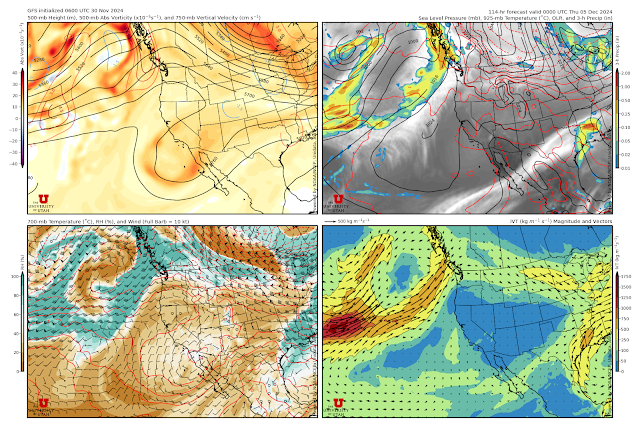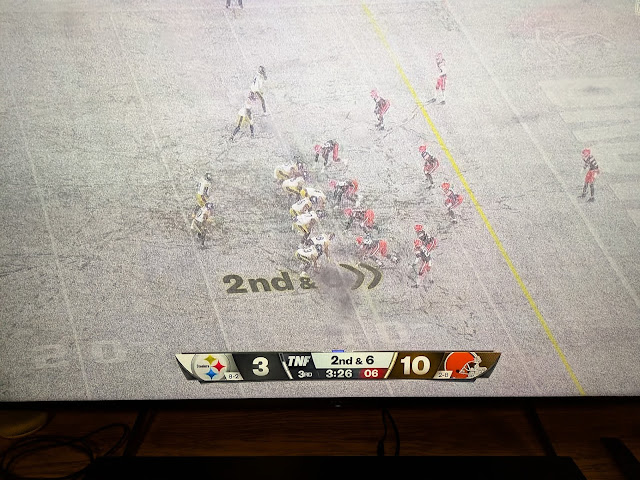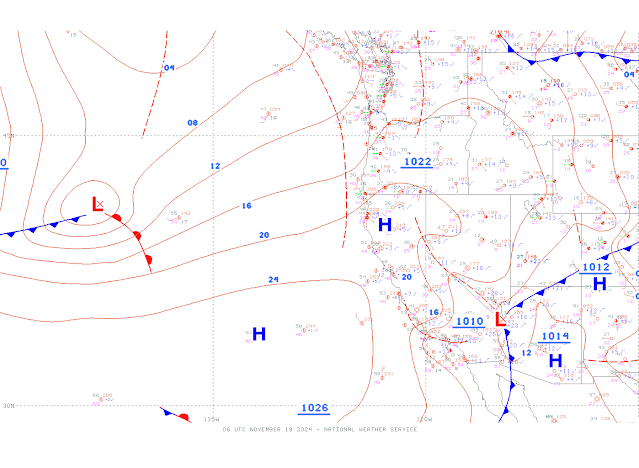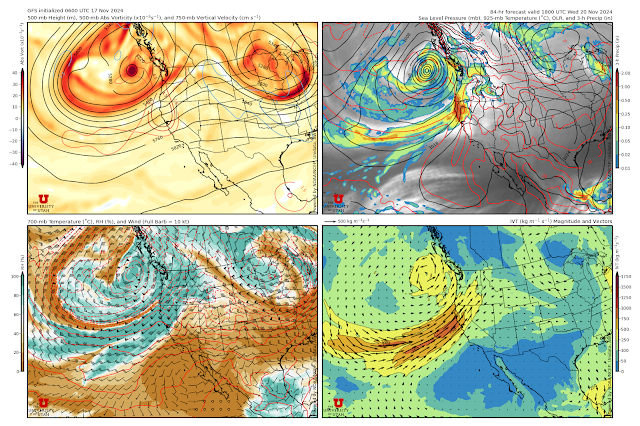We are excited to share that the RRFS Snow Ensemble is now available on https://weather.utah.edu and has replaced the old SREF product.
The RRFS Ensemble is a 6-member ensemble that is under development for future operational use by the National Weather Service. Based on the FV3 dynamical core (i.e., the software that solves the atmospheric equations of motion), it is run at 3-km grid spacing and provides forecasts out to 60 hours. The RRFS Ensemble is projected to go operational in 2024, although there have been a number of issues and challenges identified during testing that may affect that, in particular related to the forecasting of convective storms in the midwest. The RRFS Ensemble has not been carefully evaluated over the western US, so one of the reasons we are producing this product is to evaluate its fidelity for orographic precipitation.
We are also interested in testing our techniques for snow prediction. Thus, what we call the RRFS-Snow Ensemble is basically an ensemble in which we plug in new techniques to predict snow-to-liquid ratio (SLR) and snow amount. A summary of the data and methods and graphics is provided below.
Precipitation Downscaling
Although we downscale the Utah Snow Ensemble from the lower resolution global ensemble grids, the RRFS is providing forecasts at 3-km grid spacing. Thus, we are currently doing no precipitation downscaling and just using the raw model grids. There might be some advantage to downscaling the RRFS eventually, but for now, we're not doing it.
Snow-to-Liquid Ratio (SLR)
Snow-to-liquid ratio (SLR) is based on a new random forest algorithm developed using SLR observations from more than 900 Community Collaborative Rain, Hail & Snow Network (CoCoRaHS) observing sites. Thank you to all the volunteer observers and the CoCoRaHS team! In particular we are using a subset of CoCoRaHS observing sites at which the observers are taking manual cores of the snowfall data, which we hope will reduce issues related to precipitation undercatch, which is a problem with the water equivalent measured by many gauges. The random forest is trained using data from across the contiguous United States and in testing has performed better than existing operational techniques in both the western and eastern United States.
Snow Level
Identifying snow level in the west or precipitation type in the east is a bit of a thorny issue. The so-called "wet-bulb" technique that we use in the western United States works fairly well when the temperature decrease with height is close to what meteorologists call a wet-adiabatic lapse rate. It doesn't work well if the atmosphere is stable and/or has a warm nose above freezing aloft.
As a result, we decided to use a more physics-based approach to identify if snow is occurring. At each model grid point, we calculate the melting energy in the model soundings. This is the amount of energy available to melt snow in the sounding. The technique is based on Bourgouin (2000), although we use wet-bulb temperature rather than dry-bulb temperature to calculate melting energy (special thanks to Kevin Birk of the National Weather Service for providing some of the initial code for this work). Currently we are applying our random forest SLR without adjustment if the melting energy is ≤ 2 J/kg and assuming the precipitation is all rain if the melting energy is ≥ 9 J/kg. If the melting energy is between those values, we reduce the SLR between the random forest value and 0 based on linear interpolation between the two thresholds.
Those thresholds are based on published values, but admittedly, the data is not comprehensive. It may require some modification over time. However, they do give results similar to the wet-bulb method when the lapse rate is near moist adiabatic and can deal with more complicated temperature profiles.
Note that we are not attempting here to diagnose freezing rain or sleet. The melting energy approach we are using will basically give us a SLR of 0 in those instances. So, our plots only show forecasts of accumulated snow.
We are working with another group to possibly incorporate a machine learning technique for precipitation type in the future, but it may be a while before we get to that.
Four-Panel Plots
We provide loops of four-panel plots of the following variables for several regions, including over the central and eastern US:
- Total precipitation (water equivalent) since the beginning of the forecast period
- Total snow since the beginning of the forecast period
- 24-h precipitation (water equivalent)
- 24-h snow
- 6-h precipitation (water equivalent)
- 6-h snow
- 1-h precipitation (water equivalent)
- 1-h snow
- Wet-bulb 0.5°C height above ground level (based on the lowest wet-bulb 0.5°C level)
- SLR
SLR and snowfall are calculated in 1-h intervals, with the resulting 1-h accumulations summed to provide accumulations over longer periods. Thus, the 24- and total snowfall should not be confused with the change in snow depth on the ground over long time periods, which would be affected by settlement.
Each four panel plot includes the the RRFS control forecast at upper left, the ensemble mean at upper right, the ensemble minimum at lower left, and the ensemble maximum at lower right. Below is an example of the total snowfall through 60-h over the Wasatch Front.
For some of the caveats of interpreting these plots, see my blog post on
The Utah Snow Ensemble.
Plume Plots
We are also providing forecast plumes and violin plots for many locations, including several in the northeast US, to provide more information about SLR uncertainty. These are identical to those for the Utah Snow Ensemble, so refer to The Utah Snow Ensemble blog post for information on interpreting these plots. The RRFS ensemble, however, only has 6 members, so there are not a lot of forecasts and the violins are going to be based in part on interpolation fro sparse data. Some groups use time-lagging (i.e, using older forecasts) to increase the ensemble members (but also decreasing the forecast period), but we're not bothering with that for now. Perhaps at some point we will change the lower left panel from wet-bulb 0.5 level to melting energy, but for now we're keeping it consistent with the Utah Snow Ensemble. The wet-bulb 0.5°C level is based on the lowest level in the sounding, so it will not tell you where the top of a warm nose is and may not be a useful variable in situations where there is a warm nose aloft.

Caveats and Disclaimers
This is an experimental product. In fact, it is an experimental SLR product post-processing experimental ensemble modeling system! Feedback is helpful to us as we are trying to find ways to better forecast snow and its characteristics and squeeze everything we can out of the operational model suite. Tell us what works and what doesn't.
The RRFS ensemble is based on data and products from the National Centers for Environmental Prediction (NCEP), University of Utah, and other groups. These groups do not accept any liability whatsoever for any error or omission in the data and their availability, or for any loss or damage arising from their use.
This blog post may be updated as needed.























































